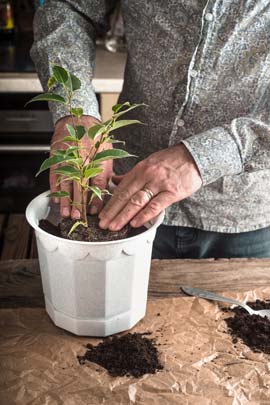Winter is a great time to repot indoor plants. Repotting encourages growth and keeps plants healthy. Check to see if plant roots have starting growing out of drainage hole or if they are erupting from their pots as roots displace the potting mix. These are signs that it’s time to repot.
 This spider plant can be divided into three smaller plants by separating it where it’s natural clusters exist.
This spider plant can be divided into three smaller plants by separating it where it’s natural clusters exist.
iStock/Thinkstock
Plants such as cast iron plant, spider plant, snake plant, clivia, philodendron and pothos, are easy to divide. These types of plants are fast-growing with clumps of multiple stems which can be separated into smaller, more manageable plants.
Plants that have a tree form or single stem such as dracaena, palm and weeping fig (sometimes called ficus), are not divided, but rather transplanted to bigger pots. When transplanting these kinds of houseplants, only go up 1 to 2 inches in pot height and width. If the pot is too large, the transplant will spend a lot of time developing roots to the detriment of top growth.
When repotting remember not to use soil from the garden, which can be contaminated with insects or disease. A good potting mix is lightweight and specially blended to encourage good drainage. Be sure to choose a new pot with adequate drainage holes. Use a saucer, plastic bin or other receptacle to capture water. After watering dump any liquid that remains in the receptacle after a few hours.
How to Divide Plants
 Plants like the ficus are single-stemmed and are transplanted to larger pots rather than divided.
Plants like the ficus are single-stemmed and are transplanted to larger pots rather than divided.
iStock/Thinkstock
- Pull or knock the plant from the pot and remove excess soil until roots are visible.
- Gently loosen the root ball with your fingers and use a sharp knife to cut the plant into sections. Each section should have a healthy root grouping and some leaves.
- Replant each division in a pot that is about 1 inch wider than the plant. The pot should be deep enough to accommodate the root ball. Plant the transplant the same depth it was growing before being divided. If planted too deep, it will rot. Too high, and roots may dry out quickly.
- Add a high quality potting mix until there’s enough to secure the roots. Continue filling the pot, tamping down the mix around the plant to get it anchored in. Apply an all-purpose plant food according to label directions. When finished, top of the soil line should be about 1 inch below the rim of the pot.
- Water thoroughly, but slowly. Use room temperature water and allow it to be absorbed by the potting mix.
How to Repot Single-stem Plants
- Pull or gently knock the plant from it’s old pot and transplant into a new one that is 1 to 2 inches larger in height and width. If the plant is extremely root bound, where roots are encircling the ball of soil, make a shallow slice through the ball from top to bottom in three our four places before moving to a new pot.
- Add potting mix, as needed, to nestle the plant in its new home and apply an all-purpose plant food according to label directions.
- Water and place in the appropriate environment.